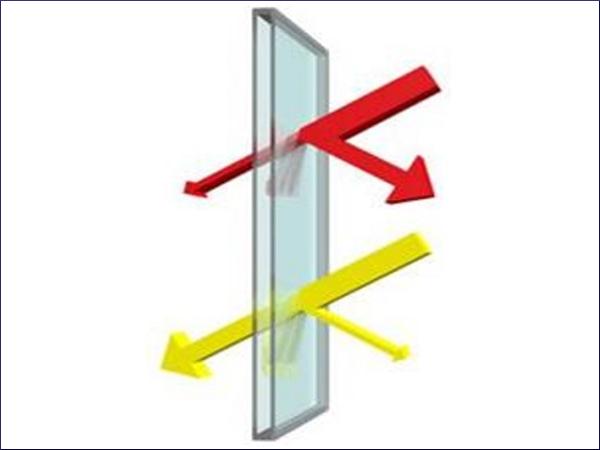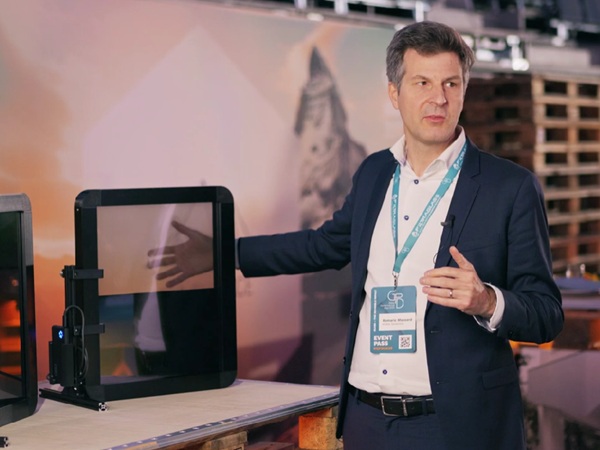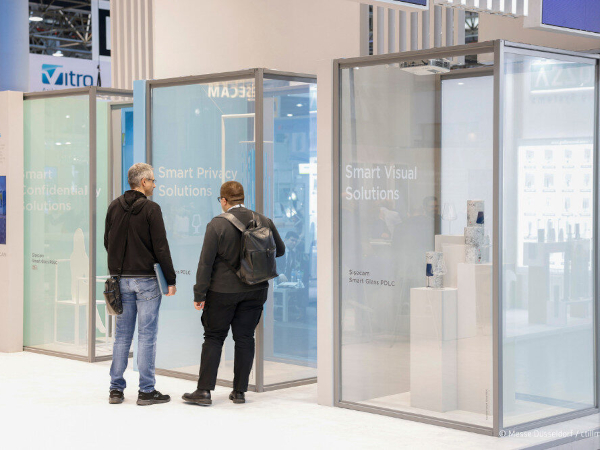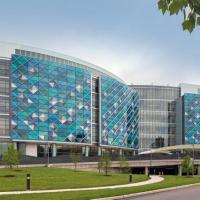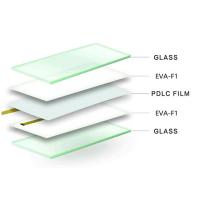Authors: Reem Taher, Walid Abdelmoneim Abdelkader and Ahmed A.Medhat A. Fahim
Source: IOP Conference Series: Earth and Environmental Science, Volume 1113, Visions for Future Cities (VFC-2022) 23/09/2022 - 25/09/2022 Cairo, Egypt
DOI: 10.1088/1755-1315/1113/1/012021
Abstract
The conventional building design provides static solutions for the building envelope, although climatic characteristics are variable parameters, which leads to a discrepancy between building and environment, and hence an uncomfortable thermal environment for occupants. Accordingly, the external facades of many conventional buildings have become a thermal burden on their occupants, necessitating mechanical solutions to achieve thermal comfort, which negatively affects the environment and causes energy crisis, air pollution, and global warming.
It is hypothesized that the usage of smart glass in the building envelope can provide optimum solutions to adapt buildings to the variable climatic and environmental characteristics, thus enhancing the users' thermal comfort and, moreover, contributing to achieving Sustainable Development Goals (SDGs), which seek to improve health, tackle climate change, and responsible energy consumption. This is approved by simulating a high-glazed office building using DesignBuilder software in its base case and after applying the proposed smart glass techniques. Then cooling loads are calculated to investigate energy consumption efficiency.
1. Introduction
Human comfort is a significant objective in Architectural Design process. People need to be safe and healthy in the building during their use. Once safety and health are assured, they need indoor environmental comfort that includes particularly thermal comfort for not only happiness but also productivity and social interactions. [1]
Buildings need to be fine-tuned to their environs and interact intelligently with local environmental conditions. This interaction is logically most performed by the building envelope (mainly for a response to desired or undesired climatic conditions) wherein changeable climates. And so, building envelopes, particularly highly glazed, should be smartly designed to interact with the surrounding environmental conditions to offer a high performance compared to the static and traditional envelope performance.[2],[3]
2. Literature Review
2.1. Sustainability, Green, and Intelligent Architecture
The integration of green design techniques and intelligent technology into the building not only reduces energy consumption and environmental impact but also reduces operating and maintenance costs, creates a pleasant and comfortable working environment, improves users' health and increases their productivity, and increases the building's value and rental income. Smart architecture contributes to achieving the Sustainable Development Goals with smart applications and modern technology that integrate with communication technology within building elements. Any smart building is a green building, not the other way around. Smart buildings have an effective performance towards the environment through positive dynamic interaction between building elements and the environment. [4] Figure1 presents the commonality of smart and green Buildings.
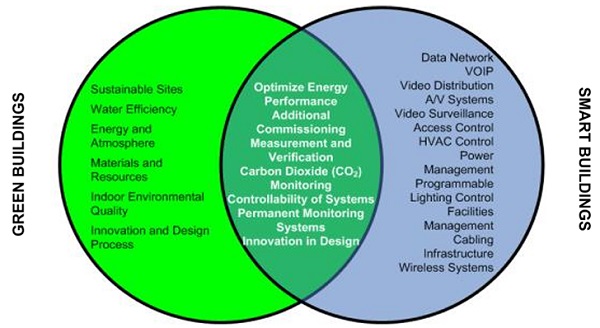
2.2 Smart Window
Smart envelope is defined as advanced performance for the building envelope with smart design related to climate conditions and technological solutions for construction such as smart windows, smart insulation, smart façade, and smart systems and smart technological equipment solutions such as smart manag ement systems, all to provide the best conditions for users such as thermal comfort, indoor wellbeing, efficient energy conservation, and efficient use of the environment. The adaptive response of a smart envelope may be in passive or active ways, or a co mbination of both. Passive responses occur without any occupant interference. On the other hand, active responses occur by integrating automatic control devices and systems into building envelope elements. Smart building envelopes are capable of selflearn ing from users and expecting the required configurations from environmental conditions changing. They also educate users, modify their actions, learn about the occupants’ needs, and select the most suitable action for each stimulus and do it. [5], [6]
Smart windows are defined as "the type of windows that partially block unwanted solar radiation and can help buildings to maintain higher energy performance levels." The smart window can realize different external stimuli, whether environmental conditions (hea t, light, etc.) or electric current and react by changing its properties (e.g., solar factor, radiation transmitted from the solar spectrum) to control indoor temperature and the light transmitted across glass. Accordingly, the smart window should control thermal absorption, thermal absorption, thermal transmittance, view, and optical transmittance. [7], [8] "Variable transmission glazing (VTG) is a smart window where the transmission properties vary to achieve the optimum luminous and thermal environments." [9] VGTs are also called dynamic or switchable glazing and have a self-shading role. Dynamic smart glazing units can be classified into three categories: chromic (thermochromic, photochromic, and electrochromic), liquid crystal devices, and suspended par ticle devices. Also, they can be grouped as active and passive glazing, as shown in Figure 2. Active glazing systems can be controlled by a building management system (BMS) responding to occupants’ needs and environmental changes. EC glazing has better pro tection from solar and UV radiation compared to SPD and LCD glass. Passive glazing systems do not need electrical stimuli; they change their properties themselves due to natural stimuli (e.g., heat and light). [10], [11]

3. Methods
DesignBuilder is the simulation tool for the case study presented in this paper. It is a userfriendly environmental modeling program where we can work with virtual building models. EnergyPlus is the simulation engine that will be used in the case study. EnergyPlus is a readymade software that is integrated into the DesignBuilder environment and allows complete simulations to be performed without leaving the interface. "EnergyPlus calculations are based on ASHRAE definitions with different methods for data handling." [12], [13]
The study consists of five phases: Site analysis and building description -analyzing the specifications of the building envelope elements and simulating this base case -applying proposed smart techniques solutions to the envelope and simulating each case -simulating the cooling loads of the base case and proposed smart cases -analytical comparison and concluding their efficiency in reaching thermal comfort requirements and conserving energy.
4. Case Study
Currently, office buildings are built with a large external glass surface and lack natural ventilation, which impacts the air quality and thermal comfort of employees in their workspaces and, consequently, their health, productivity, and adaptability. [14] Based on this, the selected case study is a proposed office building with approximately 85% single-glazed surface area; Figure 3 shows the building model created by the simulation program tools. Accordingly, this building envelope becomes a thermal burden on the occupants, which leads to extensive use of mechanical technologies to achieve thermal comfort. The case study is located in the Cairo Airport area and has a semi-square plan, as shown in figures 4–6.
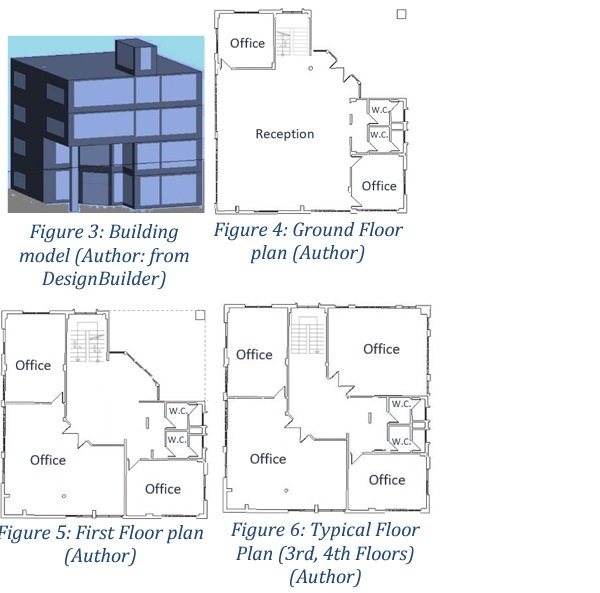
4.1. Data Analysis
Most of the architectural spaces in this office building have two orientations. Accordingly, for the ground and the typical floors, four office rooms were chosen, with the orientations of North and East-North and West-South and East-South and West (as shown in Figures 7, 8, and 9), to study the thermal performance of these spaces and compare them to the limits of thermal comfort. And likewise, the same orientations will be studied again for the four offices on the last floor (as shown in Figure 10) to determine the effect of roof thermal loads.
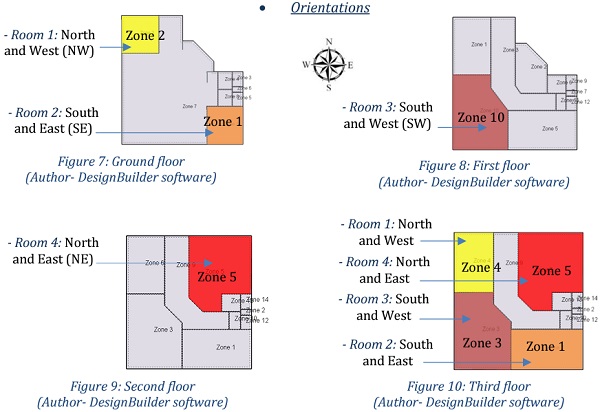
4.2. Base-case Simulation
4.2.1. Input Data
Design-Builder dialogues allow loading data into the model spaces (Activity, Construction, Openings, Lighting, HVAC, Outputs, and CFD dialogues). [13] Activity dialogues define building usage data, including data on occupancy, internal temperature set points, equipment loads and schedules, ventilation rates, and illuminance levels. Lighting dialogues identify lighting power densities for general and task lighting. Construction dialogues identify generic construction data; opening dialogues identify fenestration data and glazing type. Table 1 summarizes this data.
Table 1: Input Construction and Opening data for base-case (Author)
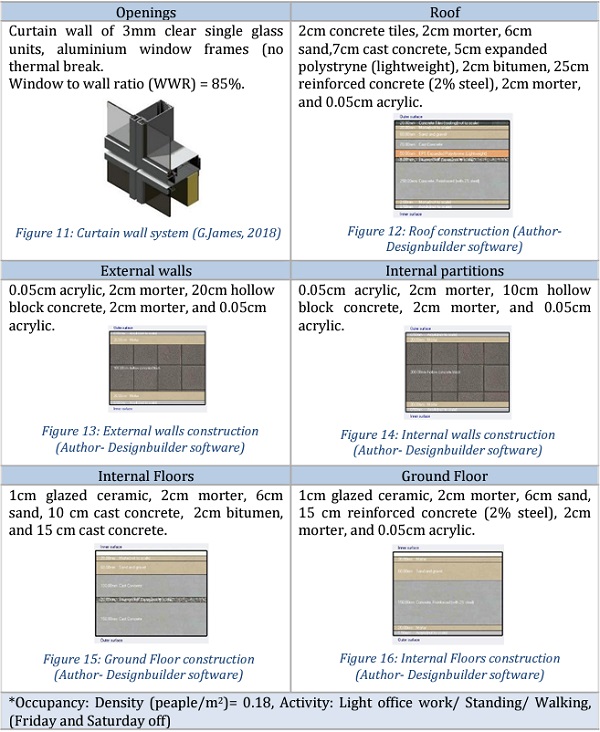
4.2.2. Output Data
According to the input data, the simulation was performed on August 19, as summer design week is from August 19 to August 25. Table 2 includes the results of the comfort data: The hourly average of the operative temperature, the outside dry-bulb temperature, and the relative humidity.
Table 2: Comfort data outputs of the base case simulation (Researcher)
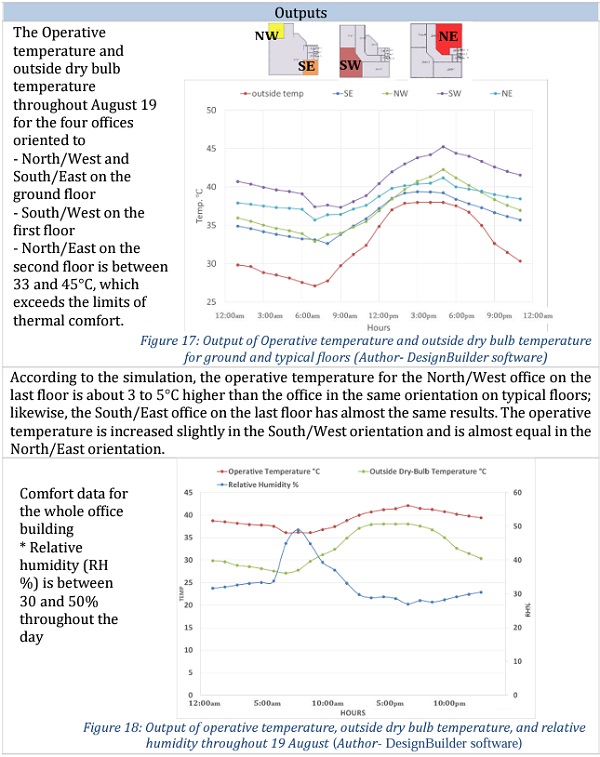
4.3. Re- simulation
From the previous simulation, the building is thermally uncomfortable, particularly the South/East and South/West offices, due to the large glass area. Accordingly, the following section will discuss some proposed smart glass to be replaced with the current glazed units to enhance thermal performance.
4.3.1. Input Data
The proposed Smart Glass Techniques:
A. Thermochromic glazing: TC glass can modify its thermo-optical properties due to a temperature difference on the external face. TC film absorbs heat, which causes phase transition or chemical reaction. Once the temperature exceeds the transition point (65°C, minimum transparency), the glass becomes opaque and becomes transparent at lower temperatures (10°C, maximum transparency), as shown in Figure 19. The most common thermochromic material is vanadium oxide VO2, which has a transition temperature of 68 °C. [6]
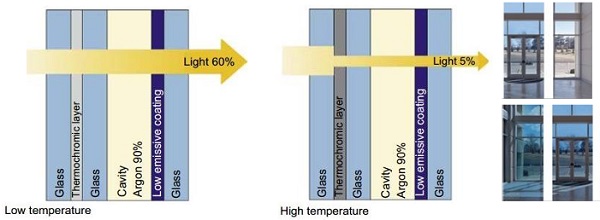
B. Electrochromic glazing: SAGE Electrochromics Inc. SageGlass Green 9mm lami full clear 49%T. EC consists of two layers of glass, two layers of transparent conductors, an electrochromic layer, an electrolyte, and an ion storage layer. When power is on, ions inflow out of the electrochromic layer, and the glass will darken. It returns to transparent when the electric field direction is reversed (Figure 20). [6], [16]
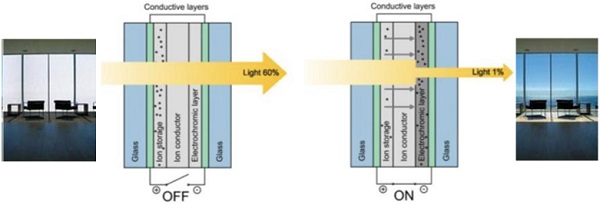
C. Low- e glass: A double-glazed unit of an outer layer of Viracon Low E II (clear glass panel with low e coating on the surface no. #2)—6mm argon—6mm of Generic clear glass panel. Low emissivity coatings are spectrally selective thin films applied to a multiple-glazing unit that let the visible light pass through and block the IR and UV wavelengths, which generally create heat to reduce radiant heat emission and provide thermal insulation. The coating is applied minimally to one surface of glass panes that face the cavity; its position depends on climate conditions. In hot climates, for increasing the reflection and reducing solar energy transmission, it is better to coat the inner surface of outer glass pane (Figure 21). [17]
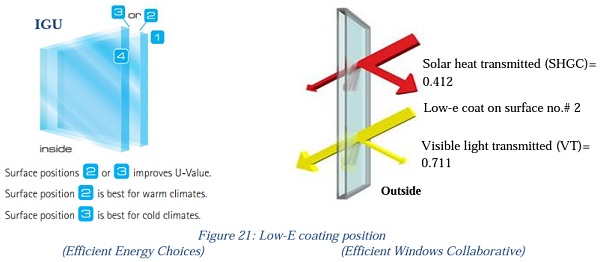
4.3.2 Output Data
The following part will discuss the outputs of smart glass solutions for the selected offices (oriented to the South/East and South/West) .
A. Thermochromic glazing
TC effectively controlled the amount of solar energy passing through the window, providing shading. Table 3 contains graphs that compare the operative temperature for the case-study offices in their base case and this proposed case.
Table 3: Outputs of Thermochromics glass. (Author)

B. Electrochromic glazing
Outputs Electrochromic windows effectively control the amount of solar and light energy that can pass through the window, providing shading. Table 4 contains graphs that compare the operative temperatures of the case-study offices in their base case and this proposed case.
Table 4: Outputs of Electrochromic glazing. (Researcher)
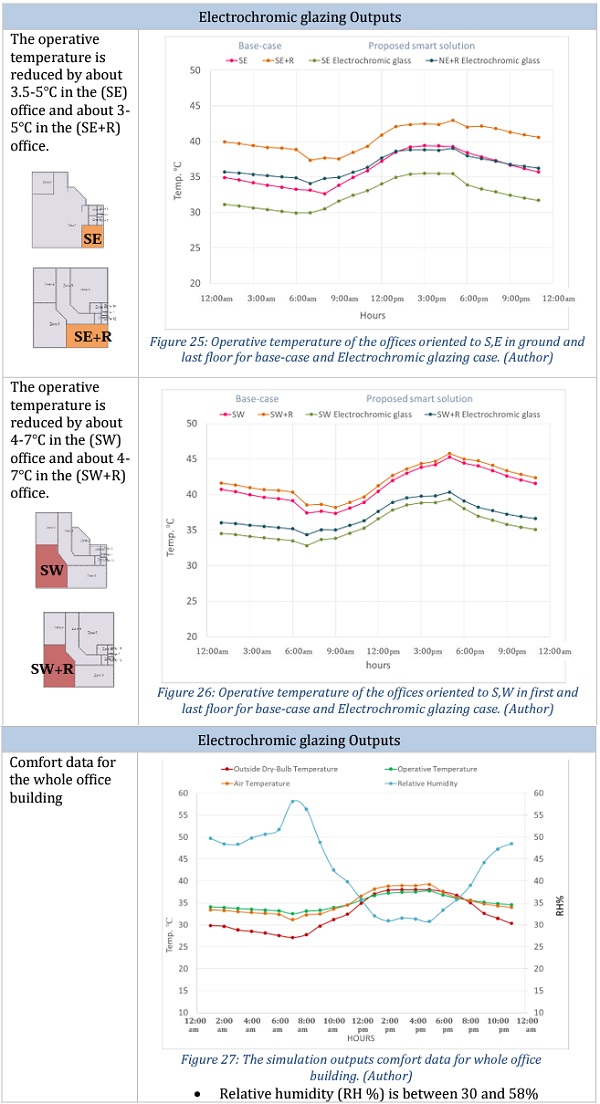
C. Low-E glass Outputs
This glazing unit provided solar and thermal control while allowing higher levels of natural daylight or visible light transmission. The thermal factor (U-value) is improved by over 60% compared to non-coated single glazing. Table 5 contains graphs that compare the operative temperature of the case-study offices in their base case and this proposed case.
Table 5: Outputs of Low-E glazing. (Researcher)
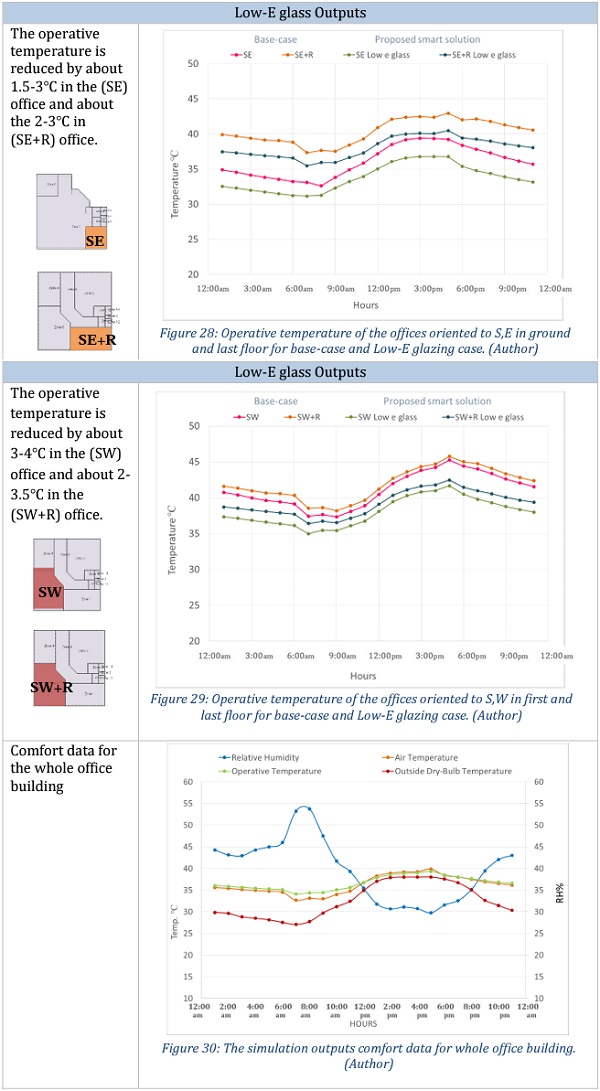
4.4. Cooling Loads
In this case study, a typical split air-conditioning unit system is used. A packaged single-zone split system uses unitary (factory fabricated) equipment that is self-contained fully to provide heating and cooling. The split unit system is the most common air conditioning system in Egypt. In this case, the split no fresh air system is put in each office room to achieve thermal comfort. For the building in its base case and each smart solution, the set-point temperature in each room is adjusted and simulated in two runs at 23 °C (recommended to save energy) and 20 °C (typically set). The energy performance results throughout August 19 are shown in Table 6 for the situation with a split unit system.
Table 6: Cooling loads outputs (Researcher)
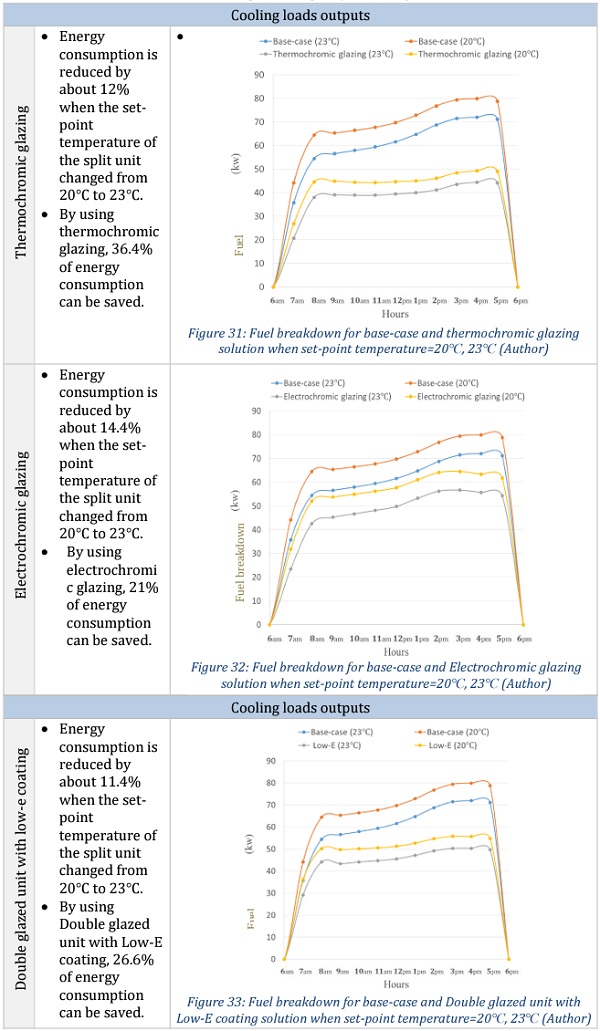
Thermal Performance: The previous simulations proved the effectiveness of retrofitting the existing glass with smart glass in enhancing the thermal performance of the building, each type in different amounts. Outputs show that electrochromic glazing achieves the best thermal performance as the operative temperature is reduced by about 3-7 °C. Thermochromic glazing provides the lowest thermal performance as the operative temperature is reduced by about 2-5 °C. According to simulation outputs, the order of these solutions due to the better thermal performance: electrochromic glazing; double glazed unit with Low-E coating; thermochromic glazing (Figure 34).
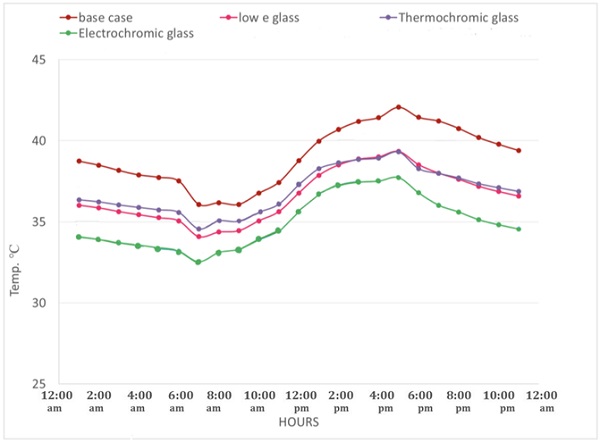
Energy Consumption: From the analytical comparison of the outputs of simulating the building with the proposed smart solutions and split air-conditioning units, smart envelopes can reduce the energy consumption for cooling by about 21 to 36.4%, depending on the solution type, as shown in Figure 35. Figure 36 summarizes the total fuel breakdown outputs (in kW) for the case study in its base case compared to each simulated smart solution when the air-conditioning unit setpoint temperature is set at 20 or 23°C. Energy consumption is reduced by about 12.5% to 14.5% when the set-point temperature of the split unit is changed from 20°C to 23.
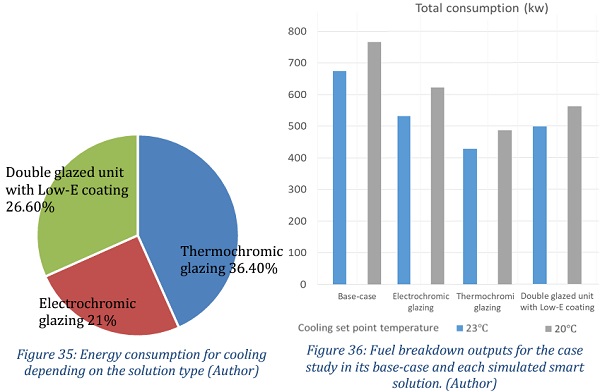
Conclusion
Smart architecture contributes to achieving the Sus tainable Development Goals with smart applications and modern technologies that integrate with communication technology within building elements. This paper presents a review of smart glass systems that contribute to creating a sustainable smart building e nvelope that tackles climate change and enhances thermal comfort for occupants in their built environments. Moreover, it demonstrates the possibility of applying these smart solutions in Egypt.
The analytical comparison of the simulation outputs proved the effectiveness of retrofitting the existing glass with smart glass in adapting to environmental conditions toward enhancing the thermal performance of the building, each type in different amounts. Outputs show that electrochromic glazing achieves the best thermal performance as the operative temperature is reduced by about 3-7 °C. Thermochromic glazing provides the lowest thermal performance as the operative temperature is reduced by about 2-5 °C. Energy analysis shows that applying split air-conditioning units to spaces with the proposed smart glass solutions can reduce the energy consumption for cooling by about 21 to 36.4%, depending on the simulated solution type. Thermochromic glazing has the best results as it saves approximately 36.40% of energy consumption. Although electrochromic glazing has better thermal performance, it saves about 21% of energy consumption as it uses electricity.
References
[1] Gamal A 2013 Design economics of smart skins of office building- Towards Aneconomic Evaluation Model of Ventilated Double Skin Facade (V. DSF) Design, Using I.T. Application in Greater Cairo (Giza, Egypt: Ph.D, Faculty of Engineering, Cairo University).
[2] Vischer J 2008 Towards an Environmental Psychology of Workspace: How People are Affected by Environments for Work Architectural Science Review 51(2) 97-108.
[3] Laftchiev E and Nikovski D 2016 An IoT system to estimate personal thermal comfort 2016 IEEE 3rd World Forum on Internet of Things (WF-IoT) (Virginia, USA: IEEE) 672–677.
[4] Radwan A H 2012 Intelligent Architecture between Contemporary Functionality and Architectural Morphology (Cairo: Faculty of Engineering, Al Azhar University).
[5] Wigginton M and Harris J 2002 Intelligent Skins (Oxford: Architectural Press).
[6] Casini M 2016 Smart Buildings Advanced Materials and Nanotechnology to Improve EnergyEfficiency and Environmental Performance (Sawston, Cambridge, UK: Woodhead Publishing).
[7] Kamalisarvestani M, Saidur R, Mekhilef S, and Javadi F S 2013 Performance, materials and coating technologies of thermochromic thin films on smart windows Renewable and Sustainable Energy Reviews 26 353-364.
[8] Baetens R, Jelle B P, and Gustavsen A 2010 Properties, requirements and possibilities of smart windows for dynamic daylight and solar energy control in buildings: A state-of-the-art review Solar Energy Materials and Solar Cells 94(2) 87-105.
[9] Allen K and Wu Y 2015 Smart Window A Window for Dynamic Control of Building Energy Performance International Conference CISBAT 2015 Future Buildings and Districts Sustainability from Nano to Urban Scale (Lausanne, Switzerland: LESO-PB, EPFL) 65-70.
[10] Juaristi M, Monge-Barrio A, Knaack, and Gómez-Acebo T 2018 Smart and Multifunctional Materials and their Possible Application in Façade Systems Journal of Facade Design and Engineering 6(3), 1933.
[11] Bahlol W S 2013 Smart Glass and Its Benefits on Energy Consumption in Buildings Chinese-Egyptian Research Journal 2 157-174.
[12] Scanferla M and Motuzienė V 2017 Energy Efficient Glazed Office Building Envelope Solutions for Different European Climates Environmental Protection Engineering 9(4) 470-481.
[13] DesignBuilder Software 2009 DesignBuilder 2.1 User's Manual (© 2009 DesignBuilder Software).
[14] Casini M 2014 Smart windows for energy efficiency of buildings. Proceedings of Second International Conference on Advances in Civil, Structural and Environmental Engineering–ACSEE (USA: Institute of Research Engineers and Doctors) 273-281
[15] FACADE SERIES. (2018). Retrieved November 9, 2020 from G.James: https://professional.gjames.com/facades/650-500-series
[16] Gavrilovic D and Stojic J 2011 Usage of "smart" glass panels in commercial and residential buildings Architecture and Civil Engineering 9(2) pp. 261 - 268.
[17] Rissman J and Kennan H 2013 Low-Emissivity Windows (Washington: American Energy Innovation Council).
[18] Resources. 2021 Retrieved 8, 2022 from Efficient Energy Choices: https://www.efficientenergychoices.com.au/files/Lowe%20Glazing%20NGP_Section_03.pdf
[19] Understanding Windows. (2018, April). From Efficient Windows Collaborative: https://efficientwindows.org/low-e-coating/

